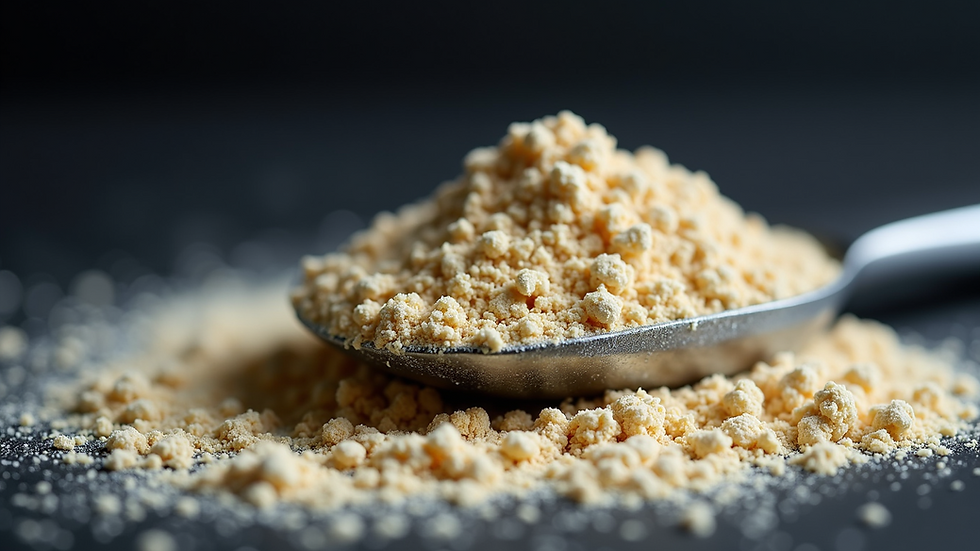Creatine's Secrets: Essential Do's and Don'ts for Optimal Results
- Flourish Everyday Health And Fitness

- Aug 6
- 4 min read
Updated: Aug 11
All I am seeing on social media these days are reports on creatine and its helpful benefits. Creatine remains one of the most researched and talked-about supplements in fitness and sports nutrition. Found naturally in our muscles, creatine plays a vital role in producing energy during high-intensity activities.
Athletes and fitness enthusiasts who are serious about increasing their output often seek it out to boost performance and enhance workout outcomes. However, many misunderstand its use and administer it incorrectly. This guide will clarify the best practices for creatine supplementation, so you can enjoy its full benefits without falling into common traps.
What is Creatine?
Creatine is a compound created from amino acids, primarily found in red meat and fish. It helps produce adenosine triphosphate (ATP), which is crucial for energy during short bursts of intense activity. On average, our bodies produce about 1-2 grams of creatine daily. However, athletes often see significant gains from supplementation. Research indicates that creatine can improve muscle strength by approximately 5-15% in trained individuals. This boost can make a considerable difference, especially during critical moments of competition or high-intensity workouts.
The Do's of Creatine Supplementation
1. Do Start with a Loading Phase
Starting with a loading phase can quickly fill your muscles with creatine. Aim for about 20 grams of creatine daily for 5-7 days, divided into four servings. This approach can help muscle stores reach peak levels in no time, leading to improved performance sooner. Studies show that those who follow a loading phase can boost their muscle creatine levels by about 20-30% more than those who take a lower dose.

2. Do Stay Hydrated
Since creatine draws water into your muscles, adequate hydration is essential to avoid dehydration. It's recommended to drink at least 3 liters of water daily, especially during intense training sessions. A great method to monitor your water intake is by purchasing a 3-liter water bottle or three large bottles. Some people even label the bottles with specific times of day to ensure they're consuming the right amount. Staying properly hydrated enhances workout performance, prevents cramping and gastrointestinal discomfort, and results in a more effective training session.
3. Do Take It Consistently
Taking your creatine supplement at the same time each day helps establish a routine. Whether before or after your workout, consistency is key to maintaining elevated creatine levels in your muscles. This regularity will ensure that you continuously reap the benefits of creatine supplementation.
4. Do Combine it with Carbohydrates
Taking creatine with carbohydrates can enhance its absorption. Carbohydrates stimulate insulin production, which helps transport creatine more effectively into muscle cells. For instance, pairing your creatine with a post-workout shake that contains 30 grams of carbs can significantly improve its uptake.Options like a banana or a carbohydrate-rich recovery drink are excellent choices for this purpose.

The Don'ts of Creatine Supplementation
1. Don't Skip the Maintenance Phase
Once the loading phase ends, switch to a maintenance dose of about 3-5 grams per day. This daily intake is essential for keeping your muscle stores elevated and ensuring you maintain the benefits you gained during the loading phase. Neglecting this step can hinder muscle growth and performance enhancement.
2. Don't Overdo It
More isn’t always better when it comes to creatine. Consuming excessive amounts can lead to side effects like diarrhea, muscle cramps, or dehydration. Sticking to recommended dosages not only protects your body but also allows you to enjoy the benefits of supplementation without unwanted discomfort.
3. Don't Rely Solely on Supplements
Creatine should be part of a well-rounded nutrition plan, not a replacement for nutritious foods.Incorporate natural sources of creatine into your diet, such as lean meats, fish, and dairy. For instance, an 85-gram serving of salmon contains about 1.1 grams of creatine. A balanced diet rich in whole foods will provide you with the necessary vitamins and minerals for optimal health and performance.

4. Don't Mix Creatine with Caffeine
While moderate caffeine consumption is generally safe, high doses may counteract some benefits of creatine supplementation. To maximize effectiveness, consider taking creatine and caffeine at separate times. This separation can help ensure each supplement works optimally in your body.
5. Don't Ignore Side Effects
Most people tolerate creatine without issues, but pay attention to your body. If you experience symptoms like stomach discomfort or bloating, consider adjusting your dosage or discontinuing use. Always consult with a healthcare professional if you're unsure or have specific health concerns.
Wrapping It Up
Creatine is a powerful supplement that can significantly enhance athletic performance, particularly in high-intensity exercises. By following the essential do's and don'ts in this guide, you will better understand how to use it effectively, maximize results, and avoid common pitfalls.
Prioritize a balanced diet, stay hydrated, and tune in to your body's responses to supplementation. With a thoughtful approach to creatine, you can unlock its potential and elevate your fitness journey. Trust in the power of creatine to boost your strength, improve recovery times, and create a more effective training regimen. Fuel your performance with confidence.





Comments